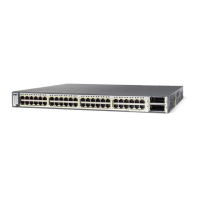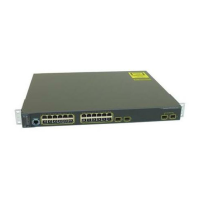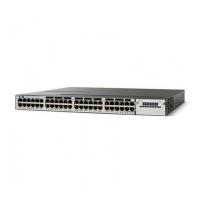13-4
Catalyst 3750-X and 3560-X Switch Software Configuration Guide
OL-21521-01
Chapter 13 Configuring Interface Characteristics
Interface Types
Although by default, a trunk port is a member of every VLAN known to the VTP, you can limit VLAN
membership by configuring an allowed list of VLANs for each trunk port. The list of allowed VLANs
does not affect any other port but the associated trunk port. By default, all possible VLANs (VLAN ID 1
t
o 4094) are in the allowed list. A trunk port can become a member of a VLAN only if VTP knows of
the VLAN and if the VLAN is in the enabled state. If VTP learns of a new, enabled VLAN and the VLAN
is in the allowed list for a trunk port, the trunk port automatically becomes a member of that VLAN and
traffic is forwarded to and from the trunk port for that VLAN. If VTP learns of a new, enabled VLAN
that is not in the allowed list for a trunk port, the port does not become a member of the VLAN, and no
traffic for the VLAN is forwarded to or from the port.
For more information about trunk ports, see Ch
apter 15, “Configuring VLANs.”
Tunnel Ports
Tunnel ports are used in IEEE 802.1Q tunneling to segregate the traffic of customers in a
service-provider network from other customers who are using the same VLAN number. You configure
an asymmetric link from a tunnel port on a service-provider edge switch to an IEEE 802.1Q trunk port
on the customer switch. Packets entering the tunnel port on the edge switch, already
IEEE 802.1Q-tagged with the customer VLANs, are encapsulated with another layer of an IEEE 802.1Q
ta
g (called the metro tag), containing a VLAN ID unique in the service-provider network, for each
customer. The double-tagged packets go through the service-provider network keeping the original
customer VLANs separate from those of other customers. At the outbound interface, also a tunnel port,
the metro tag is removed, and the original VLAN numbers from the customer network are retrieved.
Tunnel ports cannot be trunk ports or access ports and must belong to a VLAN unique to each customer.
For more information about tunnel ports
, see Chapter 19, “Configuring IEEE 802.1Q and Layer 2
Protocol Tunneling.”
Routed Ports
A routed port is a physical port that acts like a port on a router; it does not have to be connected to a
router. A routed port is not associated with a particular VLAN, as is an access port. A routed port behaves
like a regular router interface, except that it does not support VLAN subinterfaces. Routed ports can be
configured with a Layer 3 routing protocol. A routed port is a Layer 3 interface only and does not support
Layer 2 protocols, such as DTP and STP.
Note Routed ports are not supported on switches running the LAN base feature set.
Configure routed ports by putting the interface into Layer 3 mode with the no swit
chport interface
configuration command. Then assign an IP address to the port, enable routing, and assign routing
protocol characteristics by using the ip routing and router protocol global configuration commands.
Note Entering a no switchport interface configuration command shuts down the interface and then re-enables
it, which might generate messages on the device to which the interface is connected. When you put an
interface that is in Layer 2 mode into Layer 3 mode, the previous configuration information related to
the affected interface might be lost.
